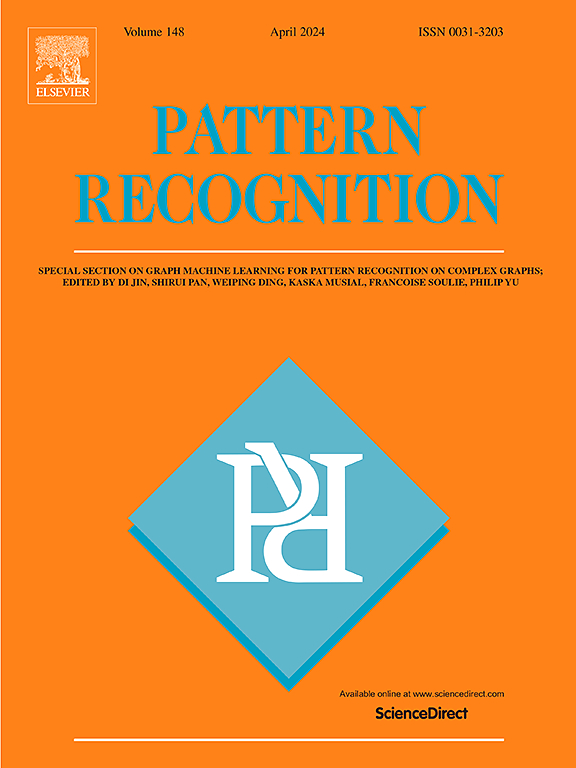Point Geometrical Coulomb Force: An explicit and robust embedding for point cloud analysis
IF 7.6
1区 计算机科学
Q1 COMPUTER SCIENCE, ARTIFICIAL INTELLIGENCE
引用次数: 0
Abstract
Recently, most existing point cloud frameworks tend to utilize max pooling aggregation functions to aggregate local point cloud features. However, when handling data containing local high-frequency noise such as local drop, addition, and jitter, this mechanism leads to high-frequency noise that spreads from local to global and causes severe performance degradation. To address this issue, we creatively extend the concepts from the physical field, namely electrostatic field and Coulomb forceinto geometric processing. To be specific, we treat the entire point cloud placed in an electrostatic field and each point as a probe charge and then equip this field with a set of source charges according to the structure of the cloud. We endow these two types of charges with different electric quantities, which could encode informative geometrical structural information. By analogously computing the Coulomb force between the probe charge and its corresponding source charge, we finally propose an explicit embedding called Point Geometric Coulomb Force (PGCF) for each point. Due to the deep use of the structural information of the point cloud and the fact that the electrostatic field of each source charge could not be affected by the variations of the probe charges, the PGCF has been proven to provide richer geometric information while being robust to local noises. Using the PGCF combined with point coordinates as inputs can significantly improve the performances of existing 3D point cloud feature extraction frameworks, including point convolution, graph convolution, and point transformer, without additional parameters or computational overhead, thus not affecting their inference speed. Experimental results show that integrating the PGCF into existing works brings more desirable results in a wide range of 3D point cloud analysis tasks, including classification, part segmentation, and semantic segmentation.

点几何库仑力:用于点云分析的显式和鲁棒嵌入
目前,大多数现有的点云框架都倾向于利用最大池聚合函数对局部点云特征进行聚合。但是,在处理包含局部下降、局部加法、局部抖动等局部高频噪声的数据时,这种机制会导致高频噪声从局部向全局扩散,造成严重的性能下降。为了解决这个问题,我们创造性地将物理领域,即静电场和库仑力的概念扩展到几何处理中。具体来说,我们将整个点云置于静电场中,每个点都作为探针电荷,然后根据云的结构在这个场中配置一组源电荷。我们赋予这两种电荷不同的电量,可以编码丰富的几何结构信息。通过类比计算探针电荷与其对应的源电荷之间的库仑力,我们最终提出了每个点的显式嵌入点几何库仑力(PGCF)。由于深入利用了点云的结构信息,并且每个源电荷的静电场不受探针电荷变化的影响,PGCF被证明可以提供更丰富的几何信息,同时对局部噪声具有鲁棒性。使用PGCF结合点坐标作为输入,可以显著提高现有三维点云特征提取框架的性能,包括点卷积、图卷积和点转换器,而不需要额外的参数或计算开销,因此不影响其推理速度。实验结果表明,将PGCF集成到现有的工作中,在广泛的三维点云分析任务中,包括分类、零件分割和语义分割,可以获得更理想的结果。
本文章由计算机程序翻译,如有差异,请以英文原文为准。
求助全文
约1分钟内获得全文
求助全文
来源期刊

Pattern Recognition
工程技术-工程:电子与电气
CiteScore
14.40
自引率
16.20%
发文量
683
审稿时长
5.6 months
期刊介绍:
The field of Pattern Recognition is both mature and rapidly evolving, playing a crucial role in various related fields such as computer vision, image processing, text analysis, and neural networks. It closely intersects with machine learning and is being applied in emerging areas like biometrics, bioinformatics, multimedia data analysis, and data science. The journal Pattern Recognition, established half a century ago during the early days of computer science, has since grown significantly in scope and influence.
 求助内容:
求助内容: 应助结果提醒方式:
应助结果提醒方式:


